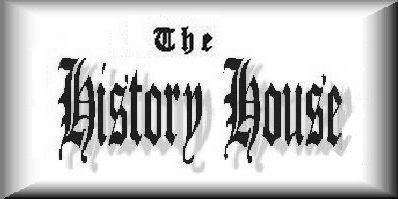| Crinoids are marine organisms which have a skeleton
made up of calcareous plates. They first appeared in the early in
the middle of the Cambrian period and survive up until the present day.
Modern crinoids have a wide distribution, and the fossil record shows a
worldwide distribution during the geological past. Crinoids were
so abundant in the Paleozoic era that their remains form vast thicknesses
of limestone. These “great forests” of crinoids probably lived in
fairly shallow water. Modern crinoids are also gregarious, tending
to live in groups often of immense numbers. They seem to prefer relatively
clear waters. |

|
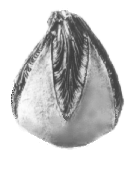 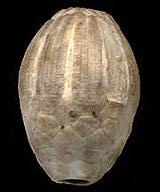
|
The popular names for crinoids are "sea lilies" for
fixed crinoids and "feather stars" for free-swimming crinoids. Crinoids
are members a group called the Echinoderms. Echinoderms include the extinct
classes Edrioasteroidea and Blastoidea. Here are two images of a blastoid
head, also known as the crown. |
| Echinoderms also include the well-known
sea animals like the Asteroidea, which are the starfish; Ophiuroidea, which
are the brittle stars; Echinoidea, which are the sea urchins and sand dollars;
Holothuroidea, which are the sea cucumbers. To learn more about Echinoids,
click on their icons below. |
 |
|
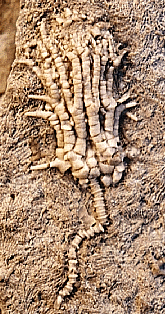
|
| Most fossil crinoids lived attached to
the sea-floor by a flexible stem, which may be either cemented to the sea
floor by the crinoid, or it may have a root-like system buried into the
sediment. Fossil crinoids have stems ranging in size from a few centimeters
to as much as 21 meters (70 feet). The stem is circular, or pentagonal
in section, and composed of numerous disc-like plates. At the top
of this stem is a cup-shaped head called the calyx, to which the arms are
attached. The calyx and the arms together are sometimes referred
to as the crown. There are usually five arms and they are used to
filter food from the water. Normally, soon after the crinoid’s death, the
entire skeleton of the crinoid disintegrates into the small separate plates
called ossicles. Often only the stem ossicles of crinoids are found
as fossils. Complete, well preserved fossil specimens are rare, and
beautiful. They look more like exotic plants, or flowers, than animals.
This accounts for their popular name "sea lilies". The images below
show an excellent example of well deserved specimen of a crinoid found
in the Witherspoon Quarry in Montgomery County, Indiana, which is a source
for such nice specimens. This particular fossil, also shown close
up, was offered for sale with an asking price of $8,000. |
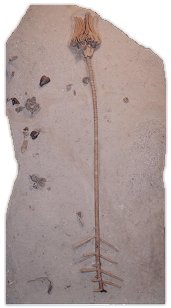 |
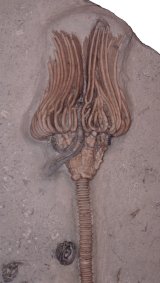 |
| Some fossil crinoids, such as Pentacrinites,
seem to have lived attached to floating driftwood and complete colonies
are often found. Sometimes the driftwood to which they were attached
became waterlogged and sank to the bottom, taking the attached crinoids
with it. The stem of Pentacrinites can be several meters long.
Modern relatives of Pentacrinites live in gentle currents attached to rocks
by the end of their stem, which is fairly short. |

|
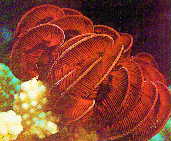
|
However, most modern crinoids are free-swimming and
lack a stem. Some
examples of free-swimming crinoid fossils are Marsupites, Saccocoma
and Uintacrinus. Many fossils of free-swimming crinoids such as Pterocoma,
are found in the Jurassic lithographic limestone of Solnhofen in Germany,
and the Cretaceous Niobrara chalk of Kansas contains large numbers of Uintacrinus.
|
| An abundance of stemmed crinoids occurs
in the rocks of the Silurian period of the United Kingdom and the eastern
United States. This is true in the Devonian period of Kentucky, Michigan,
New York state. It is also in the Eifel region of Germany, the Carboniferous
period of the United Kingdom, Belgium and Russia. There is the Mississippian
period of Iowa and Indiana, and the Pennsylvanian period of the mid-continental
United States. Such stemmed crinoids are found in the Permian period
of the island of Timor, and the Triassic period of Germany as well. |
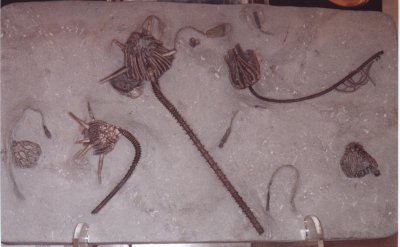
|
| Sometimes bumps or swellings with one or more holes
in their center are found on the stems of fossil crinoids. These were caused
by parasitic worms whose remains are not preserved. To see fossil
examples of the results these parasitic worms caused on the stems, or to
see fossil example of the different shapes and sizes of these stems, just
click on the icon at right to see what we have discovered. |

|
